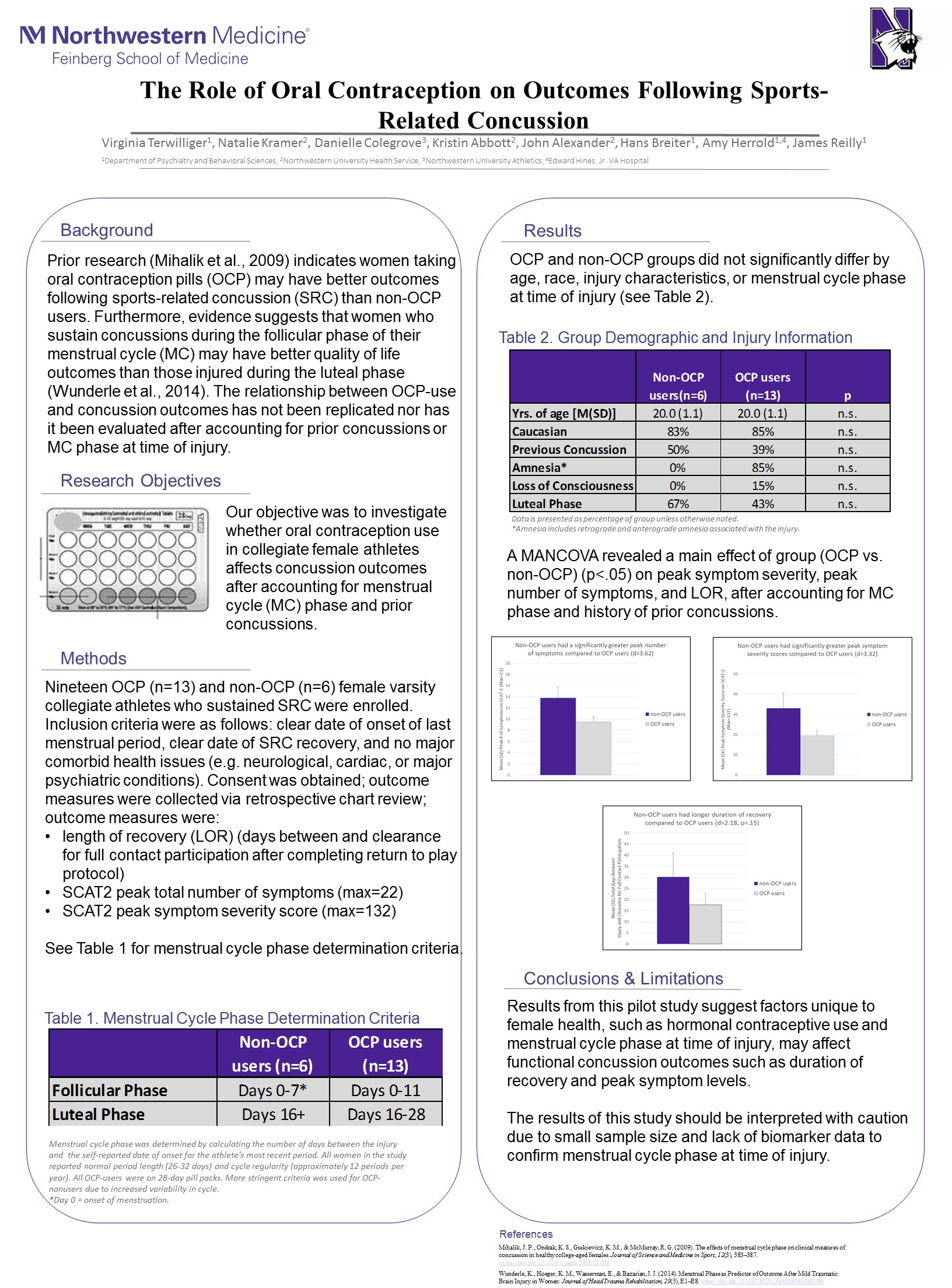Presenting Author:
Virginia Terwilliger, B.A.
Principal Investigator:
Department:
Psychiatry and Behavioral Sciences
Keywords:
concussion, mTBI, oral contraception
Location:
Ryan Family Atrium, Robert H. Lurie Medical Research Center
C123 - Clinical Women's Health Research
OCULOMOTOR MEASURES, GREY MATTER DENSITY, AND SYMPTOM OUTCOMES IN COLLEGIATE ATHLETES WITH MTBI: A PILOT STUDY
Background/Introduction: A concussion or mild Traumatic Brain Injury (mTBI) initiates a cascade of pathophysiological processes resulting in clinical symptoms such as headache, dizziness, cognitive difficulties, and emotional changes which persist to varying degrees across individuals (McCrory et al., 2013). Current standard neuropsychological tools have low specificity in distinguishing individuals with mTBI from those without mTBI and are not predictive of functional outcomes. Objective: This pilot study aimed to: 1) evaluate whether oculomotor measures are predictive of clinical outcomes (symptom (sx) severity, length of recovery) in collegiate student athletes (SA) with mTBI; 2) evaluate group differences in oculomotor measures between athletes with mTBI versus controls (CON); and 3) evaluate group differences in gray matter (GM) density in ROIs associated with oculomotor performance. Methods: Eight collegiate SA were recruited, 4 with sports-related mTBI and 4 demographically matched CON. mTBI SA completed the Post-Concussion Symptom Scale (PCSS) every 48 hours from time of injury until sx resolution. Oculomotor testing and neuroimaging were completed within 7 days of sx resolution; CON athletes were studied within 2 weeks of the mTBI athlete. Oculomotor testing consisted of pro-saccade (reflexive) and anti-saccade tasks.. Magnetic resonance imaging (MRI) was performed using a Siemens 3T Prisma scanner and T1-weighted anatomical images were acquired. T1 images were pre-processed and between group analyses were conducted using voxel-based morphometry (VBM8 for SPM8). Small volume correction (p<0.01) was used by applying an oculomotor control circuit mask comprised of the bilateral dorsolateral prefrontal cortex (DLPFC), frontal eye fields (FEF) and supplementary motor areas (SMA). Results: 1) Select oculomotor measures (reaction time, duration, and absolute velocity) were predictive of length of recovery and/or symptom severity on both the pro- and anti-saccade tasks (p<.05). 2) mTBI significantly differed from the CON on anti-saccade error rate such that mTBI group was 1.889x more likely to make a pro-saccade error than the CON group (χ2=12.881, p<.001). 3) Between group differences in GM density were found across several ROIs (p<.01), where mTBI showed lower GM density compared to CON in regions associated with the oculomotor control circuit. Conclusion: This pilot study provides initial support for the use of oculomotor measures to predict functional outcomes following mTBI in SA and to detect group differences between mTBI and CON. Further, reduced GM across an oculomotor control circuit was observed in athletes with mTBI.

